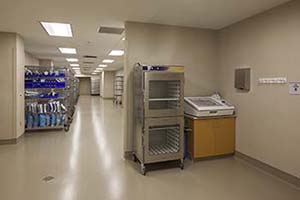 In operating room (OR) optimization, just as in a lifesaving surgical procedure, every minute counts. Small improvements in OR efficiency over the course of a year add up to substantial time and cost savings for a healthcare organization.
In operating room (OR) optimization, just as in a lifesaving surgical procedure, every minute counts. Small improvements in OR efficiency over the course of a year add up to substantial time and cost savings for a healthcare organization.
In a blended OR, typically, 60 to 80 percent of surgical cases are outpatient cases and the remaining 20 to 40 percent are inpatient cases. Because of their high predictability, surgical managers are able to schedule outpatient cases on a daily basis.
Efficient staffing and block scheduling, the standardization of OR equipment, supply and technology considerations, and layout optimization are three strategies that help improve OR scheduling and operations.
Staffing and Block Scheduling
When an OR physician is on a block schedule, they are able to schedule as many cases as can be accommodated. This often leads to idle periods in the OR, as other physicians are not able to schedule surgery unless that time is yielded to them. This forces add-on cases, which increases staff and labor costs. On the other hand, if every block is efficiently filled — yet there are still add-on cases due to high volume — this can cause capacity issues. A physician will have to push a case to a later time after block scheduling has ended. Whether the reason for lack of OR availability is inefficient block scheduling or high volume, the add-on cases drive up labor costs as an OR team has to work longer hours.
The more efficient a hospital is with OR time, the less revenue they will lose on costs of labor and facilities. The most cost-effective staffing solutions are based on predictive analytics, which analyze data in hospital’s high-traffic departments. This information, along with bed census data, allows surgery-scheduling managers to quantify case volume and structure staffing to volume and manage labor costs.
Computer simulation is an effective tool to analyze which type of procedure would be best for individual cases. It allows hospitals to assess the most effective and timely way to proceed during a surgery. The hospital is able to identify longer procedures and standardize components to avoid scheduling back-ups and overtime costs.
A surgeon may also not be performing at capacity during their block. The obvious solution is to increase the surgeon’s case volume or decrease block time. However, it is more effective to analyze trends and share the data with the physician instead of giving them an ultimatum. Working with the surgeon, asking about their capacity challenges, or offering time each day for add-ons and urgent cases will persuade most surgeons to adjust.
A partnership is fundamental to improving efficiency in the OR. This requires both the hospital and surgeons to find solutions for staffing efficiency in order to share benefits, including convenience, assigned staff, amenities and new technology.
Standardization
Standardization of equipment and supplies, technology and layout is a third strategy to optimize the OR. Even if the OR is running at peak capacity and surgical staff are well aligned with the volume and types of cases, OR teams must be supplied with the quantity, type and preferred equipment for procedures.
A physician’s preference card for supplies reflects their procedure needs, but due to limited inventory on some more expensive equipment, scheduling can be tight. The absence of tools and supplies the physician is most familiar with can slow down a procedure, causing scheduling challenges.
The solution lies in standardization of equipment and supplies to the greatest extent possible while satisfying physician preferences. By presenting inventory and cost data to the surgeons’ council, they will be able to see that unused inventory equals dollars lost. Although most physicians do not have a direct financial stake within the hospital surgery department, the savings would be able to benefit them by decreasing procedure times and reducing staffing inefficiencies. When equipment and supplies are standardized based on procedure, staff is able to prepare carts for procedures the next day and make them readily available.
Standardization of OR technology and physical layout have also improved efficiency and reduced cost as well as improving ergonomics and reducing employee fatigue and accidents. The physical layout uses a strategy based on concentric circles: a clean core for sterilized equipment surrounded by ORs and an outer ring comprised of stretcher holding bays, scrub alcoves and support spaces. The sterilized standard equipment is always available at the core and allows surgeons to move from one OR to another once they have scrubbed into the sterilized area. This standardization would enable surgical teams to operate more efficiently and streamline their procedures, saving money and increasing patient outcomes and staff satisfaction.
As Director of Strategy at Chicago-based health care consulting and design firm FreemanWhite, Michelle Mader collaborates with healthcare leaders to achieve high-level performance and identify profitable market opportunities.

